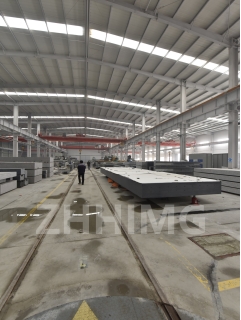Granite components are widely used in the manufacturing of various products due to their high strength, durability, and stability. The optical waveguide positioning device is one such product that requires the use of granite components to ensure precision and accuracy in positioning the optical waveguides. However, even the granite components may have some defects that can affect the performance of the optical waveguide positioning device. Fortunately, these defects can be eliminated or minimized through proper maintenance and quality control measures.
One of the defects that may occur in granite components is the presence of surface scratches or chips. These defects can be caused by mishandling or improper use of the components during the manufacturing process or installation. Such defects may interfere with the movement of the optical waveguides, affecting the accuracy of the positioning system. To avoid this defect, it is recommended to implement quality control measures during the manufacturing process to inspect the components for any surface defects and repair or replace them as necessary.
Another defect that may occur in granite components is thermal instability. Granite components are sensitive to fluctuations in temperature, which can cause them to expand or contract, leading to dimensional changes that can affect the precision of the positioning system. To overcome this defect, manufacturers of optical waveguide positioning devices must ensure that the granite components are stabilized at a constant temperature during the manufacturing process, and that they are installed in a controlled environment to maintain their stability.
In some cases, granite components may also crack or fracture due to mechanical stresses or excessive loading. This defect can also occur during the manufacturing process or installation of the components. To avoid this defect, it is important to ensure that the components are properly supported and secured during the manufacturing process and correctly installed in the positioning device. Regular inspections and maintenance can also help to identify any early signs of cracking or fractures before they become a serious problem.
Finally, poor surface finish is another defect that may occur in granite components. A rough surface finish on the components can affect the smooth movement of the optical waveguides, leading to inaccuracies in the positioning system. This defect is usually caused by poor quality manufacturing or improper polishing of the components. The best way to avoid this defect is to implement quality control measures during the manufacturing process to ensure that the components have a smooth and even surface finish.
In conclusion, the use of granite components in the manufacturing of optical waveguide positioning devices is an effective way to ensure precision and accuracy in the positioning system. However, defects may occur in the components, including surface scratches or chips, thermal instability, cracking or fracture, and poor surface finish. These defects can affect the performance of the optical waveguide positioning device. To overcome such defects, manufacturers must implement quality control measures during the manufacturing process, ensure proper installation of the components, and conduct regular inspections and maintenance of the device to minimize any potential defects. With these measures in place, defects in granite components can be avoided, and the optical waveguide positioning device can function smoothly and accurately.
Post time: Nov-30-2023

